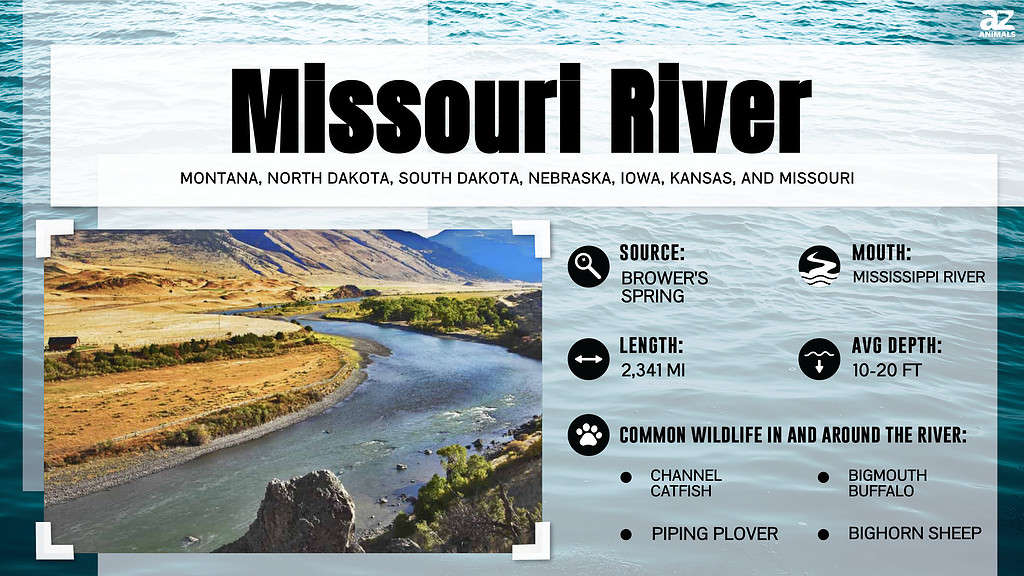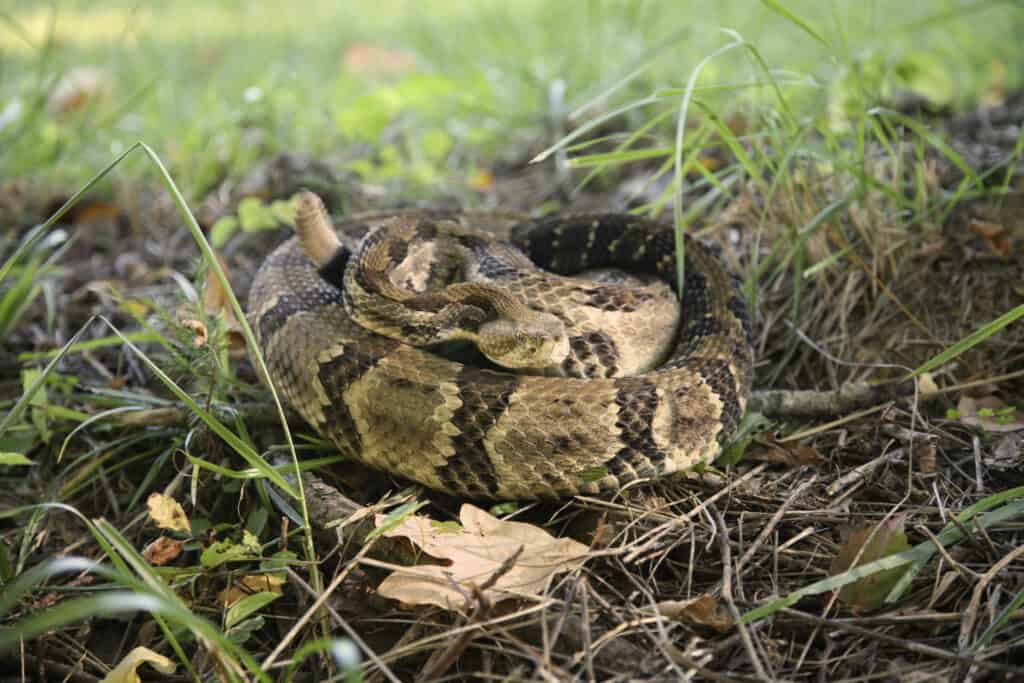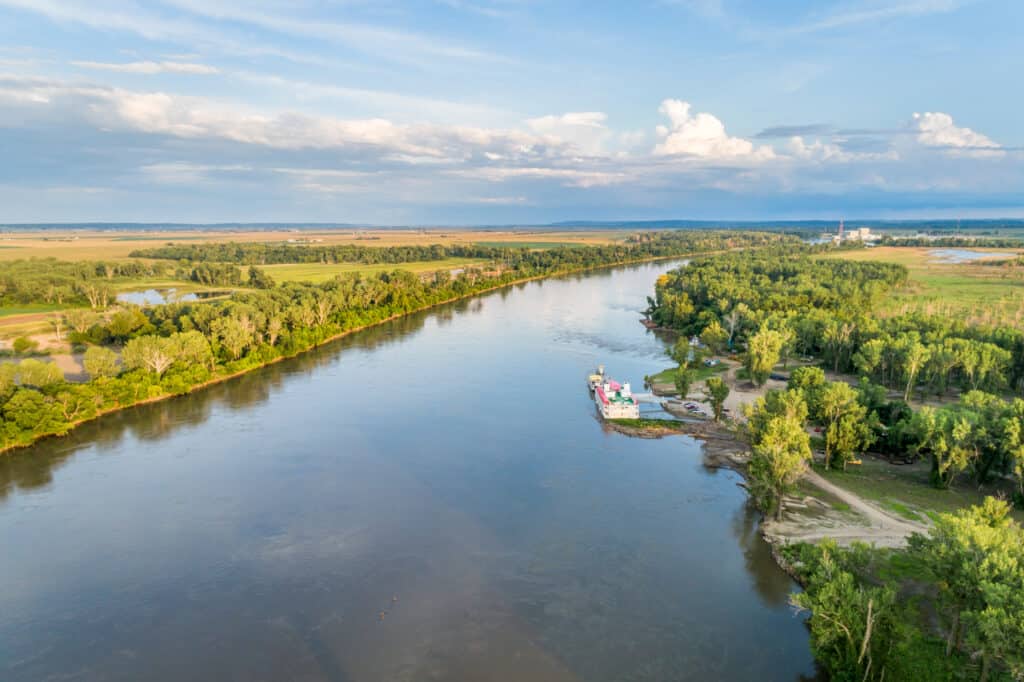Key Points:
- The Missouri River is the longest river in the U.S. at a length of 2,341 miles. It originates in Montana’s Rocky Mountains and flows northward, eastward, and southward before joining the Mississippi River just above St. Louis.
- While the Missouri River provides cooling water for power plants, drinking water for local communities, and a low-cost highway for goods and agricultural products, it can also be treacherous at times, producing floods that endanger homes, communities, and farms.
- There are over 200 species of fish inhabiting the Missouri River, as well as a variety of reptiles like alligators, snakes, and turtles.

The longest river in the United States, the Missouri River, meanders through ten American states, supplying vital water resources to many people. Nevertheless, concerns about pollution levels and their effects on wildlife have arisen regarding this mighty river. The quality of the river’s water has deteriorated due to agricultural runoff, industrial waste, and sewage, resulting in increased bacterial presence and detrimental chemicals.
Additionally, the Missouri River supports various aquatic species, such as fish, avian creatures, and mammals, which may potentially endanger swimmers. So, is swimming in the Missouri River safe? Let’s find out!
The Missouri River has been pivotal for countless generations, serving as a provider of food, travel, and trade for millions. Often referred to as the “Center of Life” for the Great Plains area, its significance remains undiminished. The river’s watershed spans over 500,000 square miles, crossing ten US states and one Canadian province.
Missouri River

The Missouri River is the longest river in the United States.
©marekuliasz/Shutterstock.com
Spanning more than 2,341 miles, the Missouri River holds the title of North America’s lengthiest river. It begins in Montana’s Rocky Mountains and flows northward, eastward, and southward before uniting with the Mississippi River just above St. Louis.
Its width is difficult to measure precisely, with its topography varying significantly along different sections of its flow. For example, the Missouri River is known to stretch over 13 miles at its broadest point. And its depth fluctuates from 10 to 20 feet based on the location, and in some of its more profound sections, it can plunge to depths of an incredible 150 feet!
Despite its importance, the Missouri River can be treacherous at times, producing floods that endanger homes, communities, and farms. Yet, it also provides cooling water for power plants, drinking water for local communities, and a low-cost highway for goods and agricultural products.
The Missouri River is a great destination for outdoor enthusiasts, with numerous activities to enjoy, from scenic boat tours and kayaking to fishing. Hiking along the riverbanks or paddleboarding are other options for visitors. For a unique experience, visitors can take a hot air balloon ride over the river or explore the Lewis and Clark Trail. History buffs can also visit the historical Fort Benton.
Where Is the Missouri River on a Map?
The Missouri River begins in the Rocky Mountain region of western Montana and meanders north, east, and then south for 2,341 miles, finally joining the Mississippi River north of St. Louis. It’s the longest river in North America. From Montana, it passes through the Canadian provinces of Alberta and Saskatchewan in its northward flow, then passes through the states of North Dakota, South Dakota, Nebraska, Kansas, Iowa, and Missouri.
What Is In The Missouri River?
Are you wondering what might be hidden under the Missouri River’s surface and if it’s safe for visitors? Let’s dive in and uncover its secrets.
Fish

Lake
sturgeon
is the largest fish found in the Mississippi River reaching an average length of 7 feet.
©Kletr/Shutterstock.com
The Missouri River boasts an impressive array of fish species, with a total of more than 200 species making their home in its waters. Among the largest is the lake sturgeon, which can reach an average length of 7 feet, while the least darter is the smallest at only 1.5 inches on average.
Unfortunately, not all species of fish in the Missouri River are thriving. For example, the pallid sturgeon has been facing a population decline for decades. Since 1990, the pallid sturgeon has been classified as an endangered species. Sadly, there are only about 200 adult pallid sturgeons left in the upper Missouri River.
Despite this, there are still plenty of game fish in the river, including smallmouth bass in the Ozarks and upper Mississippi River. Trout are abundant in the upper reaches of the Missouri River, with over 4,500 per mile, and there are numerous insect hatches throughout the river, making it an excellent spot for fishing.
It is possible to swim safely in certain sections of the Missouri River, but exercising caution and remaining mindful of potential dangers is crucial. While most fishes in the river are not dangerous to humans, swimmers should be aware of a few. Contrary to some beliefs, there is no evidence of the bull shark in the Missouri River.
On the other hand, the blue and flathead catfish have venomous spikes on their dorsal and pectoral fins that can cause harm or injury. It’s essential to avoid areas where these types of fish are present to prevent injury.
Reptiles

The venomous timber
rattlesnake
is native to the region surrounding the Missouri River.
©iStock.com/NajaShots
The Missouri River is home to a wide variety of reptiles, in particular, 47 species of snakes. Although alligators have not been sighted in these waters, caution must be exercised when swimming in waters where these wild creatures may lurk.
A venomous snake species native to the region surrounding the Missouri River is the timber rattlesnake. The adults can grow up to astonishing 60 inches in length. This snake species is usually found residing in wooded hillsides, forests, and river bottoms.
The northern watersnake is the most prevalent watersnake species in the Missouri River region. Although it has no venom, it can defend itself by biting. Graham’s crayfish snakes, on the other hand, are the smallest water snakes in the Missouri River, with some adult snakes only measuring about 18 inches. These snakes spend their winters in abandoned crayfish burrows and feed on freshly molted crayfish.
While most of the water snakes in the Missouri River area are generally considered non-venomous, it is still advisable to avoid swimming near them. These wild animals can be unpredictable and may bite if they feel threatened or cornered.
Even non-venomous snake bites can cause pain and may lead to infections. It is advisable to exercise caution and minimize interactions with these reptiles whenever possible to ensure one’s safety.
In addition to snakes, the Missouri River also supports various other reptile species, such as turtles and lizards. For example, the river is home to the common snapping turtle, which can weigh up to 40 pounds and has a powerful bite.
Water Pollution

The Missouri River struggles with pollution from sources such as agricultural runoff and industrial waste.
©iStock.com/Lana2011
The Missouri River faces a significant pollution problem, which mainly consists of invisible toxins that make it the seventh most polluted waterway in the United States. The pollution comes from various sources, such as agricultural runoff, irresponsible development, and industrial waste.
Water pollution has resulted in a reduction of commercial fishing harvests by 80%. In 2007 alone, Missouri dumped over 11,000 pounds of pollution in the Missouri River, with Bayer CropScience contributing 342 pounds through chemical release.
In 2008, 21,000 lake acres and numerous streams were affected by mercury deposition in the water, posing a severe risk of mercury poisoning to those who consume the fish caught in these waters.
Not only that, taking a dip in contaminated water may lead to numerous health concerns, including skin irritations, ear complications, breathing difficulties, and digestive issues, as a result of the detrimental elements found in the pollution.
Pollution in the Missouri River also significantly impacts aquatic life, alters the river’s ecosystem, and negatively affects the water quality.
If you’re interested in swimming in the Missouri River, it’s essential to identify areas with clean water. The Black River is an example of such an area and is regarded as one of Missouri’s cleanest riverways because of its transparent water and rock floor. Whether swimming, floating, snorkeling, or sunbathing, the Black River is an ideal spot to enjoy your time in the water safely. If you are planning on swimming in other areas, make sure you do your research before diving in.
Sediment
The Missouri River has a rich history where sediment flow has played an equally crucial role as water flow in various river processes. However, with the construction of dams and bank control structures, the sediment volume carried by the river has significantly reduced.
Sediment comprises an assortment of unconsolidated materials, including sand, clay, silt, and various soil particles, which accumulate at the base of the river. Originating from processes such as soil erosion or the decomposition of flora and fauna, these particles are carried to water bodies like streams, lakes, and rivers, aided by natural forces including wind, water flow, and frozen precipitation.
It is likely that the primary origin of suspended sand in the lower Missouri River results from the excavation of the main-stem channel located downstream from the upper Missouri River impoundments. Every year, Louisiana receives roughly 145 million metric tons of sediment transported by the Missouri and Mississippi Rivers combined.
Although sediment processes are vital for many ecosystems and critical to specific species, swimming in areas with high sediment levels is not usually recommended, as it can be a safety hazard. Notably, sediment can reduce visibility, making it challenging to spot underwater hazards like debris, rocks, and logs. Moreover, sediments can harbor dangerous substances such as bacteria and chemicals, posing health risks to swimmers.
It is also worth adding that sediment can also have a significant impact on aquatic life and ecosystems. High levels of sediment in the water can block sunlight, making it difficult for aquatic plants to grow and produce oxygen. This can lead to reduced oxygen levels in the water, harming fish that need the oxygen to survive. Sediment can also make it difficult for fish to breathe by clogging their gills, and it can also bury or destroy critical habitats such as spawning beds and feeding areas. Furthermore, in some cases, sediment can introduce harmful pollutants and toxins into the water, negatively impacting aquatic life and the environment.
Wreckage
It may come as a shock, but the Missouri River has experienced a significant number of sunken ships. Over a period of nearly 80 years, from 1819 to 1897, a total of 289 steamboats met their demise while navigating the Missouri River. Unfortunately, only 17 of these sunken steamboats have been recovered so far.
Most of these mishaps occurred in the area where the Missouri and Osage Rivers meet. This area was particularly treacherous due to the discharge of the two mouths of the Osage River, which were located about four miles apart.
The wreckage in a river can pose a significant threat to swimmers, especially if it is situated in a shallow part of the river where it can potentially obstruct swimming paths. However, in case the wreckage settles in a deep pocket on the riverbed, it may not impede swimmers as much.
Nevertheless, it is still crucial for swimmers to exercise caution and use discretion when selecting areas to swim in order to avoid any inconvenience or potential danger. Before entering the water, swimmers should scout the area and steer clear of swimming near known areas with debris or wreckage.
Is The Missouri River Safe To Swim In?

While some areas of the Missouri River are safe for swimming, other areas pose considerable risks.
©marekuliasz/Shutterstock.com
The Missouri River, similar to other expansive water bodies, presents various hazards that swimmers ought to consider before entering. While certain sections of the river may be appropriate for swimming, not all parts are ideal for leisure activities.
A primary concern when swimming in the Missouri River is the fluctuating water flow and current. The river’s unpredictable nature can produce powerful currents capable of sweeping even skilled swimmers away from the shoreline. Moreover, water flow can alter swiftly, potentially placing swimmers in perilous situations if they are not vigilant.
An additional issue to consider is the potential presence of pollutants and floating debris in the water. The Missouri River functions as a vital water supply for agricultural, industrial, and residential zones, resulting in the possibility of contaminants entering the water through rainwater runoff or wastewater discharge. Swimmers must be mindful of the potential health hazards linked to contact with polluted water.
It is essential for swimmers to select a designated swimming area that is both clean and devoid of debris. Adhering to all displayed rules and guidelines, such as swimming during daylight hours and never swimming alone, is equally important. Wearing a life jacket can further enhance safety while in the water.
The photo featured at the top of this post is © iStock.com/Matthew Howieson
Thank you for reading! Have some feedback for us? Contact the AZ Animals editorial team.






